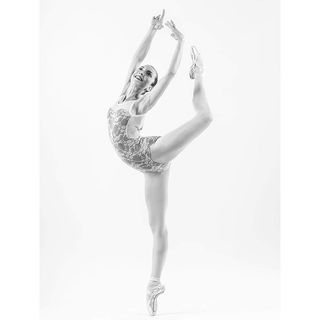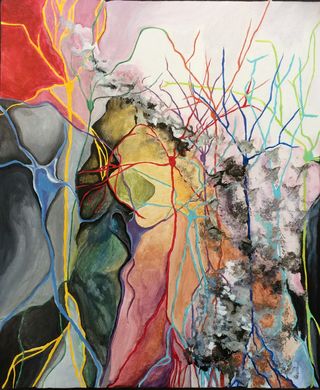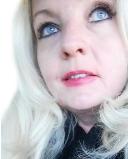Synesthesia
"As If Dancing Through Watercolors"
The San Diego Ballet's Zoe Marinello-Kohn's synesthetic inner scenery.
Posted July 12, 2019

There is a grace about Zoe Marinello-Kohn that transcends the dance. Though she is a ballerina with the San Diego Ballet, and a choreographer, her way of describing the synesthesia she experiences is just as considered and fluid as her movements.
For example, not long ago she had the opportunity to dance outdoors. "I recently attended a rehearsal out in the vast plains of the Flint Hills where there was to be a performance," she says. "This was my first time dancing out in the elements and it is significant to me because of the unpredicted extra stimulus that I encountered during the run. The wind left light blue traces on my skin."
I had the pleasure of speaking with this poetic swan recently by phone. This is our Q & A.
Can you describe your favorite ballet dance and what you are sensing as you move across the stage?

ZMK: The first role that comes to mind is the iconic role of Snow Queen in "The Nutcracker."
(See her masterful performance here.) This is one of the most rewarding roles I have had the opportunity to perform for several years now. I love dancing this role in particular because the music looks a lot like snow drifts with spiking dark chords of trumpets marking the crescendos and cymbals creating dramatic explosions of grey. The drifting swaths of milky, misty music and the harder ebony lines look almost like a moving snow-covered landscape with trees and dark storm clouds. I love when music mimics the theme–I find the character comes to me intuitively when this happens and I can become the Snow Queen–dancing fully in character surrounded by this musical landscape. The choreography for this piece has a lot of lifts and partnering. After many years I feel more comfortable in this role than any other and can enjoy it more than something I have just learned. Along with my partner who I trust and know very well I can really go for it and push myself, really moving big and sometimes feeling like I’m flying.
Another role that is dear to me is the role of Osage Woman in "Wahzhazhe: An Osage Ballet." I’ve been so grateful to be a part of this ballet since the very beginning, performing it at the Smithsonian Museum of the American Indian and at the Festival of Families when Pope Francis came to Philadelphia. The ballet tells the story of the Osage people. Beginning before Europeans came to America and highlighting significant historical events up to the present day. The music is so structured and even that in places it almost has an architectural quality. It’s the kind of score that would make me want to dance even if I weren’t in the performance. There is something deeply satisfying to me when the movements, emotion and music match my synesthesic responses to the stimulus. Since my movements (either because of the name of the step- example: a glissade is a sliding jump and is a 'red' word) or spatial trajectory (example: whenever I move forward I feel as though I’m moving 'red') or the emotion of the character (example: determination feels 'red') are all, for lack of a better term, 'color-coded', and if they match the music it feels calming and right. This happens many times in this ballet and I find an equilibrium that is carried through the performance. There is a power in the music that I can feel in my body and I do my best to allow the intentions of the choreographer and director come through me through the colors of emotion.
Can you tell me about your desire to compose? What sorts of melodies would you like to dance to?
ZMK: When I began to choreograph I was drawn to music with a clear melodic pattern with distinct shapes and colors. The first piece I choreographed was very literal (to me!) and had three women dancing the blue section and three other women dancing the amber section.
Later as I had choreographed more I felt as though I had hit a dead end. I was frustrated because I really felt the need to create a piece that explored a series of recurring dreams I had been having. The problem was I needed music as abstract and absurd as the dreams were and I couldn’t find anything that fit the vision of what I had in mind...
During the off-season, I decided to enroll in a class at City College and learned the basics of electronic music composition. I am in no way an expert or really much more than barely competent with using this technology but in that class, I was able to learn what I needed to capture the sounds I wanted to paint the background for this piece. I don’t see much of a difference between dance, music and painting. Especially when I am moving, all three have the same culmination of a temporary painting surrounding me. It is like a watercolor I paint and then it dissipates into the air.
One obstacle I found in choreographing to my own score was that very subtle musical cues would be very hard to communicate to my dancers. I had to find ways of counting music that I had formed to look like fog. I had to reach for alternative language to set choreography–it wasn’t possible to say something like 'pique arabesque on the bright red line'. Another challenge in choreography is that I must constantly remind myself that the audience is not perceiving the color and shape of the music. Even if my work is viewed by a synesthete, what they experience will most likely be very different from me. I need to be very conscious of this and make sure to represent my whole vision on the stage. If I want the piece to have a certain emotional quality I often try to represent that in the color of lighting or costumes, in movement or how the dancers touch each other.
When did you first realize you are a synesthete? What are some of the simple associations like
letters or numbers that might have come up first?

ZMK: I realized I was a synesthete when I was watching an episode of 'Weeds'. In the episode one of the characters said something about numbers having colors and I remember turning to mom and saying wait- doesn’t everybody have that? This was the first time I realized that my perception was different from those around me. It’s taken years to identify all the forms of synesthesia that I have. I don’t think enough of us take the time to really sit with our senses and explore their perimeters, their limits and their connections. It’s been very important for me not just as an artist but as a conscious human to explore and truly know this reality. Identifying my types of synesthesia has been a meditation and has helped me in my relations to others by forcing a sense of empathy. Over time I have found I experience spatial sequence, color-grapheme, sound/color, smell/color and touch/ color synesthesia as well as others. The only sense that does not have any other association is taste and it is a demonstration of how unimaginable these phenomena are to people that don’t experience them that I assume that taste synesthesia would be quite distracting even though my own synesthesia is just absorbed into my consciousness and in no way hinders me.
In fact at times I am so moved by what I sense that it makes me incredibly sad to know that I am the only one who can perceive this song or that smell with the purest ink line of the clarinet or the softest cloud of pink. It makes me feel lonely and lucky all at the same time. Also, I rarely need a calendar since I have a color-coded calendar in my mind and that sure comes in handy!
Did being a student at a Waldorf school open you up to your synesthesia in any way? Did teachers there know what it is?
ZMK: I was not aware I had synesthesia until I was about 23. I really think Waldorf was the right school for me and I can’t imagine growing up in any other atmosphere. Where so many of my senses are intertwined I believe Waldorf school blends education with life skills. Because of Waldorf school, I didn’t watch a lot of television as a child and I wasn’t pushed to accelerate academically just for the sake of passing a test. Waldorf education emphasized learning through the arts, it placed more of a value on teaching us how to reason than what to think.
I remember that there was a lot of ambiguity in our lessons. A lot of storytelling and a lot of handwork such as painting, drawing, clay work, woodwork, sewing, gardening and even blacksmithing. We played games and organized sports. We learned how to read and write and also built a tool shed and milked the cow. Using my fine motor skills and learning how to make real, physical, touchable objects tethered me to reality.

School wasn’t just hours of non-relatable abstract concepts. It was a way to learn about the world through creative expression. We had a bio-dynamic farm that was part of our campus and farming was a class. Planting seeds, tending to the plants and harvesting the fruit made every year a cycle of anticipation and patience. Mostly what I believe Waldorf aspires to do is create a space for each student to learn at his or her own pace and express themselves naturally and without judgment. Now, I realize the privilege that came with this type of education. It makes me incredibly aware of how lucky I was to be in an atmosphere that allowed me to use all my senses and gave me the tools I needed to communicate my thoughts and provided me with a variety of mediums to express myself.
Please describe your work in other mediums and how they are the same as dance in many ways.
ZMK: One day I was at home by myself. I was sick and couldn’t go to school and was painting to pass the time. I was probably about 12 years old and I had a small revelation that really changed me from that day onward. In the lower grades at Waldorf, we were always encouraged not to copy subject matter in our drawings or paintings but to use our imagination. Later we began to be asked to draw objects as they are or to copy famous masterpieces from history. This transition took me from the ethos of the limitless to the substantial solidity of the real world. I remember as I was painting that morning at home I was trying to copy a model's face from a magazine and it wasn’t working. I had added all the shading, all the proportions were correct and yet she didn’t look alive. After a long time, I realized I needed to put in highlights of white where the light hit her face. I needed to identify what I actually saw not what I felt was there or what I imagined made up the construction of a face. Really taking the time to see her face clearly and study it to the point of being able to replicate it has been probably the most valuable lesson of my life. This has had an impact on me beyond just fine art. When one's emotions, physical sensations and cognition of sound, smell and sight are all fired by and in relation to one another by varying degrees and by external triggering, it is more important than ever to define the truth in each separate sense and understand how and when it prompts the perception and manifestation of another.
Once I made these distinctions it gave me the freedom to harness them and utilize them in my art. Since most of my senses produce some sort of visual manifestation, I often work to create a visual interpretation for the audience of my work. When I paint I can paint not only what is obviously an accurate portrait but also the emotional colors or physical tones that I want to be part of the viewers' experience. When I choreograph I can interpret the music as I see it or I can create conflict with movements counter to the patterns in the harmony. I believe that everyone has reactions that they don’t understand and that coming to a place of knowing between the conscious and subconscious is my personal key to finding where I fit into this world. Knowing we are different not only externally but internally calls for higher levels of empathy and a drive for understanding. Not only to imagine walking in another’s shoes but hearing and tasting and seeing what they see.




